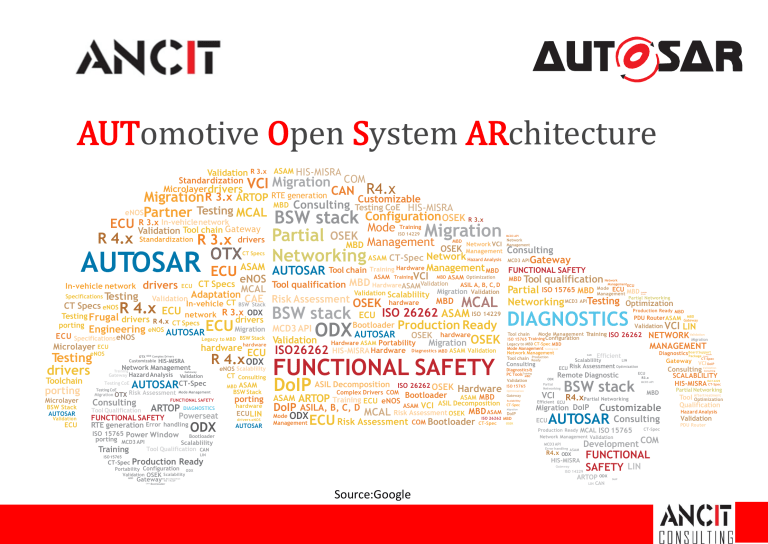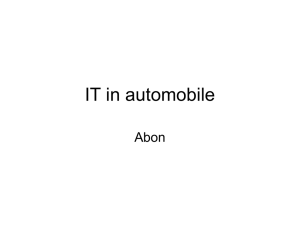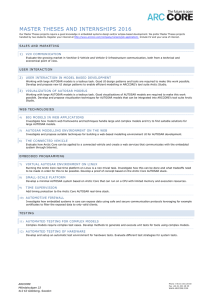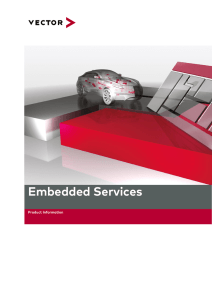
AUTomotive Open System ARchitecture Validation R 3.x ASAM HIS-MISRA Standardization Migration COM Microlayerdrivers CAN R 3.x ARTOP RTE generation Customizable MBD Consulting Testing CoE HIS-MISRA Testing VCI Migration eNOSPartner ECU R 4.x MCAL R 3.x In-vehiclenetwork Validation Tool chain Gateway Standardization drivers R 3.x OTX AUTOSAR Testing CT Specs eNOS ASAM OSEK BSW stack Configuration Mode Migration Partial OSEK Management MBD OSEK Consulting Networking CT-Spec Network Gateway ISO 14229 ASAM ECU CT Specs R 4.x Microlayer ECU drivers Toolchain porting Microlayer BSW Stack AUTOSAR Validation ECU OTX ODX Complex Drivers Customizable HIS-MISRA Network Management Gateway Training Gateway Hazard Analysis Testing CoE Testing CoE Management VCI Tool chain Training Hardware MBD MBD ASAM Optimization ASAM Training ASIL A, B, C, D HardwareASAMValidation qualification Migration Validation Validation BSW stack hardware hardware ECU R 4.x ODX eNOS Scalablility Validation AUTOSARCT-Spec Risk Assessment Migration OTX Consulting Mode Management FUNCTIONAL SAFETY ARTOP Tool Qualification DIAGNOSTICS Powerseat FUNCTIONAL SAFETY RTE generation Error handling ISO 15765 Power Window Bootloader ODX porting MCD3 API Training CT Consulting MBD ASAM BSW Stack porting hardware ECU LIN drivers eNOS AUTOSAR Production Ready ODX AUTOSAR OSEK Validation Migration OSEK ISO26262 Bootloader hardware Portability HIS-MISRA Hardware Diagnostics MBD ASAM Validation Hardware ASAM FUNCTIONAL SAFETY DoIP ASIL Decomposition ISO 26262 OSEK Complex Drivers COM Management ECU Risk Assessment COM Bootloader Network Management MCD3 API FUNCTIONAL SAFETY MBD Tool qualification DIAGNOSTICS Tool chain Mode Management Training ISO 15765 Training Configuration Legacy to MBD CT-Spec MBD Network Management Production Tool chain Ready Consulting Diagnostics & PC ToolsTraining MBD Validation ISO 15765 Optimization Gateway Scalablility CT-Spec Migration DoIP OSEK CAN ECU ODX Efficient R4.xPartial Networking ECU Production Ready MCAL ISO 15765 Network Management Validation Source:Google R3.x MCD3 API MBD CT-Spec Development COM FUNCTIONAL SAFETY LIN LIN Bootloader CAN DoIP CT-Spec VCI DoIP Consulting Validation SCALABLILITY ISO 14229 HIS-MISRA CT-Spec Consulting ECU Customizable ECU AUTOSAR Consulting ARTOP ODX ISO 14229 Gateway Migration DoIP ISO 14229 ASIL D ec o mposition Complex Drivers BSW stack Gateway OSEK Scalability Gateway Support DiagnosticsBoard Package Risk Assessment Optimization R4.x ODX HIS-MISRA Validation Validation LIN Remote Diagnostic Partial Networking VCI Efficient MBD Gateway VCI LIN NETWORK Migration MANAGEMENT Validation ISO 26262 Scalablility Error handling ASAM LIN PDU RouterASAM Mode Management Testing CoE ISO 26262 MBD CT-Spec Network Management Complex Drivers MCD3 API CT-Spec Production Ready Portability Configuration ODX C AN Hardware ASAM MBD ARTOP Training ECU eNOS Bootloader ASIL Decomposition ASAM VCI DoIP ASILA, B, C, D MCAL Risk Assessment OSEK MBD ASAM Mode ODX ASAM Scalablility Tool Qualification CAN ISO 15765 MBD Network VCI Management Hazard Analysis ECU eNOS AUTOSAR ECU Testing MCD3 API MBD Testing Frugal drivers drivers R 4.x CT Specs porting Migration MCD3 API Engineering eNOS AUTOSAR ECU Specifications eNOS Legacy to MBD BSW Stack eNOS R 3.x Training MBD ECU ECU MBD ISO 15765 MBD Mode MCAL Tool Partial Management Scalablility Partial Networking Validation Adaptation CAE Risk Assessment In-vehicle CT BSW Stack OSEK hardware MBD MCAL Networking MCD3 APITesting Optimization Production Ready MBD ECU network R 3.x ODX ECU ISO 26262 ASAM ISO 14229 drivers In-vehicle network Specifications CT Specs R4.x Partial Networking Tool Aftertreatment Optimization Qualification Hazard Analysis Validation PDU Router ABOUT ANCIT Speaker Next Generation Tooling and Engineering Service Provider for Automotive and Aerospace Industry Dr.B.Kaarthick, Director-R&D, ANCIT 16+ years of experience in Research Products Product Development Custom Tool Development Consulting Services Training Services Awarded as One of the Top 10 Innovators of India in 2016 By DST, Government of India Website : www.ancitconsulting.com Email : bk@ancitconsulting.com| Contact : +919787400605 Motive of the WEBINAR Agenda • Why AUTOSAR? • AUTOSAR Layered Architecture • Design and Communication of AUTOSAR Software Components Why AUTOSAR ? Why AUTOSAR ? . Source:google Why AUTOSAR? Automotive Industry coping up with increasing complexity • One of the biggest problems faced by the Automotive Companies was that the software must often be rewritten from scratch when hardware is changed. • BSW Standardisation: AUTOSAR standardised the BSW system. This provides an opportunity for the software developers to now focus on customer features and functionalities, thereby increasing the competitive value. OEM will prefer to pay only for Application Software but not for the BSW. • Hardware Abstraction: AUTOSAR provides hardware abstraction i.e., AUTOSAR provides a software module called as Microcontroller Abstraction Layer (MCAL) that makes the Basic Software (BSW) and the application layer independent of the the Microcontroller. The software developer can now focus on building the application than on worrying about configuring the micro controller. Why AUTOSAR? • Reusability of functions: across vehicle networks and across OEM boundaries. One of the biggest challenges faced by the OEM was when an OEM wanted to add a function to an existing ECU it required a lot of effort. With the introduction of AUTOSAR this large effort when reusing functions has been reduced. Partitioning and relocation of functions has also been made possible with the introduction of AUTOSAR. • Standardization of exchange formats: Before AUTOSAR every supplier to the OEM developed products in an ad-hoc mode. This created a lot a compatibility issues as OEM’s work with different suppliers for different products. AUTOSAR is working on standardising the specification of exchange formats. This allows an opportunity for seamless integration among different products from different suppliers. Interfaces has been standardised. Why AUTOSAR? . Organizations can focus on specializations. For instance, ANCIT can focus on building great Airbag application software. OEM can buy application from ANCIT, BSW from BOSCH and microcontroller from Infineon. AUTOSAR Layered Architecture APPLICATION LAYER RUN TIME ENVIRONMENT B A S I C S O F T W A R E SERVICES LAYER ECUABSTRACTION LAYER MICROCONTROLLER ABSTRACTION LAYER MICROCONTROLLER AUTOSAR Layered Architecture COMPLE X DRIVERS Basic Software The Basic Software Layers are further divided into functional groups. Examples of Services are System, Memory and Communication Services. Application Layer Runtime Environment System Services Memory Services Crypto Services Off-board Communication Services Communication Services Onboard Device Abstraction Memory Hardware Abstraction Crypto Hardware Abstraction Wireless Communication HW Abstraction Communication Hardware Abstraction Microcontroller Drivers Memory Drivers Crypto Drivers Wireless Communication Drivers Communication Drivers Microcontroller I/O Hardware Abstraction I/O Drivers Complex Drivers AUTOSAR Basic Software Module AUTOSAR has defined a set of BSW modules. They are responsible for different tasks: Operating System Access to non volatile memory Communication via CAN, LIN, FlexRay and Ethernet Handling the diagnostics Access to I/O ports System services like ECU state management In addition, so-called Complex Device Drivers can be integrated into an AUTOSAR ECU. They are used to access the features of the ECU, which are not covered by the standard BSW of AUTOSAR. Microcontroller Abstraction Layer • The Microcontroller Abstraction Layer is the lowest software layer of the Basic Software. • It contains internal drivers, which are software modules with direct access to the µC and internal peripherals. ECU Abstraction Layer Microcontroller Abstraction Layer Task Make higher software layers independent of µC Properties Implementation: µC dependent Upper Interface: standardized and µC independent Microcontroller ECU Abstraction Layer • The ECU Abstraction Layer interfaces the drivers of the Microcontroller Abstraction Layer. It also contains drivers for external devices. • It offers an API for access to peripherals and devices regardless of their location (µC internal/external) and their connection to the µC (port pins, type of interface) ECU Abstraction Layer Microcontroller Abstraction Layer Microcontroller Task Make higher software layers independent of ECU hardware layout Properties Implementation: µC independent, ECU hardware dependent Upper Interface: µC and ECU hardware independent Complex drivers Layer The Complex Drivers Layer spans from the hardware to the RTE. Properties Implementation: might be application, µC and ECU hardware dependent Upper Interface: might be application, µC and ECU hardware dependent 25 ECU Abstraction Layer Microcontroller Abstraction Layer Microcontroller Complex Drivers Task Provide the possibility to integrate special purpose functionality, e.g. drivers for devices: which are not specified within AUTOSAR, with very high timing constrains or for migration purposes etc. ECU Abstraction Layer The Services Layer is the highest layer of the Basic Software which also applies for its relevance for the application software: while access to I/O signals is covered by the ECU Abstraction Layer, the Services Layer offers: Task Provide basic services for applications, RTE and basic software modules. Properties Implementation: mostly µC and ECU hardware independent Upper Interface: µC and ECU hardware independent 26 Services Layer ECU Abstraction Layer Microcontroller Abstraction Layer Microcontroller Complex Drivers Operating system functionality Vehicle network communication and management services Memory services (NVRAM management) Diagnostic Services (including UDS communication, error memory and fault treatment) ECU state management, mode management Logical and temporal program flow monitoring (Wdg manager) RTE Layer • • Above the RTE the software architecture style changes from “layered“ to “component style“. The AUTOSAR Software Components communicate with other components (inter and/or intra ECU) and/or services via the RTE. Task Make AUTOSAR Software Components independent from the mapping to a specific ECU. Properties Implementation: ECU and application specific (generated individually for each ECU) Upper Interface: completely ECU independent 27 AUTOSAR Runtime Environment (RTE) Services Layer ECU Abstraction Layer Microcontroller Abstraction Layer Microcontroller Complex Drivers • The RTE is a layer providing communication services to the application software (AUTOSAR Software Components and/or AUTOSAR Sensor/Actuator components). Application Layer and RTE Application Layer AUTOSAR Runtime Environment (RTE) Services Layer ECU Abstraction Layer Microcontroller Abstraction Layer Microcontroller Complex Drivers The Application Layer contains the SWCs, which realize the application functionality of the ECU. This is the piece of software that the OEM is ready to pay . Sometimes the OEM build some of the applications to protect their IP. CAN STACK Architecture . Application CAN STACK • manages sleep/wake up functionality. • CAN Bus Interface Layer carries out all hardware tasks, related to the flow of data to the upper layer modules of the CAN software stack. • UDS Software Stack to manages the diagnostics • Flash Bootloader Application for ECU Reprogramming.. • segmenting the data, if the size of the data frame is more than 8 Bytes. CAN DRIVER CAN HARDWARE The CAN driver enables the access to hardware resources, for the upper software layers. It also offers access to the hardware API, to the application layer. AUTOSAR Software Component Application Software Component Actuator Software Component Sensor Software Component AUTOSAR Interface AUTOSAR Interface AUTOSAR Interface Standardized Interface Interfaces: BSW relevant Possible interfaces inside Basic Software (which are not specified within AUTOSAR) Operating System Standardized Interface VFB & RTE relevant RTE relevant AUTOSAR Interface ............ AUTOSAR Runtime Environment (RTE) Interface Standard Software AUTOSAR Software Application Software Component Standardized AUTOSAR Interface Standardized Interface AUTOSAR Interface Services Communication ECU Abstraction Standardized Interface Standardized Interface Standardized Interface Basic Software Standardized Interface Microcontroller Abstraction ECU-Hardware Simplified Component View AUTOSAR Interface Complex Device Drivers AUTOSAR Methodology ‘ Design and Communication of Software Components SeatHeatingControl SeatHeatingControl with seven software components SeatHeatingControl • SeatHeatingControl • Input: • Whether a Passenger is sitting on the seat ”SeatSwitch” • Setting of the seat temperature dial “Setting” • Some information from a central power management system “Power Management” • Output: • DialLED associated with the seat temperature “DialLED” • Heating Element to be Turned ON “HeatingElement” Sender-Receiver RPORT Client – Server RPORT The Component reads/consumes values of data-elements The Component requires operation defined in the interface Client - Server PPORT Sender - Receiver PPORT The Component provides operation defined in the interface The Component provides values of dataelements 3 Sender Receiver Interface Client Server Interface Design and Communication of software Components Communication between SWCs takes place chiefly over two kinds of ports, Client/ Server ports where server is a provider of a service and the client is a user of a service and Sender/ Receiver ports where a sender distributes information to one or several receivers in synchronous as well as asynchronous environment. The implementation architecture of SWC is formally defined in terms of so-called runnable entities. They correspond to procedures and are executed on a specific event such as a periodic activation or reception of new input value. During system design phase the SWCs can be integrated with their environment (e.g. hardware, driver, OS, etc) based on Virtual Functional Bus (VFB). Atomic Software Component- Smallest software component which will remain in one ECU only. Cannot be broken between ECUs. Atomic Component and Runnables two instances of the “SeatHeatingControl” component-type are used to control the left front seat, respectively the right front seat. These components will typically have their own separate internal state (stored in separate memory locations) but might for example share the same code AUTOSAR Supports Multiple Instantiation AUTOSAR System View Ports Syntax & Semantics AUTOSAR Software Component Application Software Component Actuator Software Component Sensor Software Component AUTOSAR Interface AUTOSAR Interface AUTOSAR Interface Standardized Interface Interfaces: BSW relevant Possible interfaces inside Basic Software (which are not specified within AUTOSAR) Operating System Standardized Interface VFB & RTE relevant RTE relevant AUTOSAR Interface ............ AUTOSAR Runtime Environment (RTE) Interface Standard Software AUTOSAR Software Application Software Component Standardized AUTOSAR Interface Standardized Interface AUTOSAR Interface Services Communication ECU Abstraction Standardized Interface Standardized Interface Standardized Interface Basic Software Standardized Interface Microcontroller Abstraction ECU-Hardware Simplified Component View AUTOSAR Interface API CALLS Complex Device Drivers AUTOSAR Interfaces AUTOSAR Interfaces are used in defining the ports of software-components and/or BSW modules. Through these ports, software-components and/or BSW modules can communicate with each other AUTOSAR makes it possible to implement this communication between Software-Components and/or BSW modules either locally or via a network. The AUTOSAR Interface is a generic interface which is derived from the ports of a SWC. AUTOSAR Interfaces are provided by the RTEand serve as interface between SWCs or between SWCs or between a SWC and the ECU firmware (IO HW and Complex Drivers). Via these interfaces, a SWC can e.g. read an input value or write an output value. The Standardized AUTOSAR Interface is an "AUTOSAR Interface” whose syntax and semantics are standardized in AUTOSAR. Such interfaces are used by the SWCs to access AUTOSAR Services, which are provided by BSW modules of the Service Layer like the ECU manager or the diagnostic event manager. The Standardized Interface is an interface, which is predefined by the AUTOSAR standard as API in C language. It is used between BSW module within an ECU, between RTEand Operating System (OS), or between RTEand the Communication Layer. AUTOSAR Summary Future Plans To create an AUTOSAR Learning Group in India [in collaboration with SemiCon, Tier 1, OEM , Service Providers and Universities] ANCIT will continue to deliver Series of Webinars Create AUTOSAR Learning Kit & Easy to Learn AUTOSAR Stack Tools and Automation Support for AUTOSAR Development Next Webinar: Application Software Component Development You will learn: • How to create an system file (arxml) • How to build a system level application software component • Generate <*.c> and <*.h> file • Build the ASWC <*.c> Date: Sep 3, 2020 Time: 3pm EDB EDITOR EDB Editor Features: • Create the electrical database in the form of excel file. • Signals and node addition or removal. • Message event or cyclic time conversion. • Add or remove message in to the database file(excel) • Edit existing database files. • Convert the one format file(excel) to other(vector dbc/arxml). ex: vector database to .arxml standard & vice versa. Conversation made as per new file conversion standard. Available for download from: August 15,2020 Its FREE!!!! EDB EDITOR FEATURES 1. easness to create the electrical database in the form of excel file. 2. easiness on signals and node addition or removal. 3. easiness on message event or cyclic time conversion. 4. easiness to add or remove message in to the database file(excel) 5. the above mention the feature can be added or removed on the already exist database file. 6. easiness to convert the one format file(excel) to other(vector dbc/arxml). example: vector database to arxml standard and vice versa. it's required becuse of due to huge autosar adaptation is taken place in the automotive industry and development and testing tools are made and understandable by old format. 7. Conversation will be made as per new file conversion standard and quality will be assured. Our Locations Registered Office 4/1, Sri Krishna Villas, 1st Cross, Kongu Nagar, Ramanathapuram Coimbatore,TN, India Pin : 641045 Ph : +91-422-6461778 Consulting Office #28, Shankar Mutt Road, Bangalore, KA, India. Pin : 560004 Ph : +91-80-41244277/+91-8023163244 In Germany PW-tech Unterhaunstädter Weg 3 85055 Ingolstadt, Germany In US Four Colors Technology LLC 3828 Tonsley Pl High Point, NC 27265 | Website : www.ancitconsulting.com Email : bk@ancitconsulting.com Contact : +919787400605




